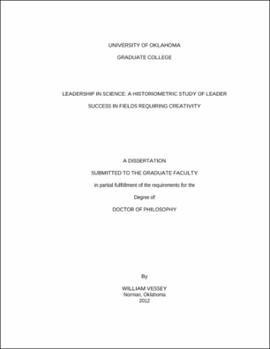| dc.contributor.advisor | Mumford, Michael D | |
| dc.creator | Vessey, William Brandon | |
| dc.date.accessioned | 2019-04-27T21:24:31Z | |
| dc.date.available | 2019-04-27T21:24:31Z | |
| dc.date.issued | 2012 | |
| dc.identifier | 99164612502042 | |
| dc.identifier.uri | https://hdl.handle.net/11244/318607 | |
| dc.description.abstract | In recent years there has been a marked increase in the study of the influence of leadership on creativity, and the effects of this relationship on organizational performance. While a number of explanations have been broached with regard to the positive effects of leadership on creativity, many of these studies propose different, and often contradictory, methods for leaders to achieve these positive effects on creativity within their organizations and work groups. Additionally, little work has been done examining the effects of leadership on highly creative people in fields requiring creativity. The purpose of this study is to examine existing theories regarding the leadership of creative people in the context of a highly creative population that uses creativity as a fundamental marker of performance: eminent scientists. Ninety-three excerpts from the biographies of scientists were content coded for leader behaviors and performance criteria. The results of this analysis indicate that a model based on strategic planning and project championing may serve as the best explanation of the positive effects of leadership on creativity in a highly creative population. | |
| dc.format.extent | 77 pages | |
| dc.format.medium | application.pdf | |
| dc.language | en_US | |
| dc.relation.requires | Adobe Acrobat Reader | |
| dc.subject | Leadership | |
| dc.subject | Science | |
| dc.subject | Creative ability in science | |
| dc.subject | Scientists | |
| dc.title | LEADERSHIP IN SCIENCE: A HISTORIOMETRIC STUDY OF LEADER SUCCESS IN FIELDS REQUIRING CREATIVITY | |
| dc.type | text | |
| dc.type | document | |
| dc.thesis.degree | Ph.D. | |
| ou.group | College of Arts and Sciences::Department of Psychology | |
